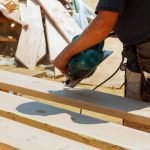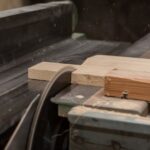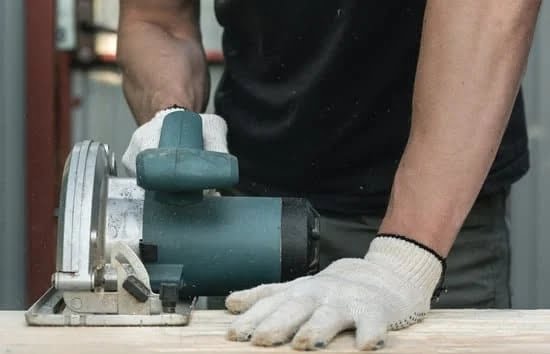Wood scribing is an essential skill for any woodworking enthusiast or professional. It involves the technique of carefully fitting woodwork pieces to uneven or irregular surfaces, ensuring a seamless and precise finish. In this article, we will explore the art of wood scribing and why it is crucial in the world of woodworking.
The process of wood scribing allows craftsmen to create a seamless joint between two pieces of wood, even if the surfaces are not perfectly straight or level. It ensures that there are no gaps or uneven edges between joined pieces, resulting in a visually pleasing and structurally sound finished product. Whether you’re working on cabinetry, furniture making, or home renovations, knowing how to properly scribe wood is vital for achieving professional-level results.
Wood scribing also plays a significant role in maximizing the efficiency and effectiveness of your woodworking projects. By accurately measuring and marking your woodwork pieces before cutting, you can avoid wastage caused by inaccurate cuts and incorrect fittings. This not only saves you time but also reduces material costs in the long run. Additionally, mastering the art of wood scribing enables you to tackle more complex projects that involve uneven surfaces or intricate angles.
Throughout this article, we will delve into various aspects of wood scribing, starting with choosing the right tools for the job and preparing the wood before moving on to step-by-step instructions for the actual scribing technique. We will also cover common mistakes to avoid, tips for dealing with irregular surfaces, advanced techniques such as compound scribing and coping, troubleshooting common challenges that may arise during the process, and finally finishing techniques.
By following these guidelines and honing your skills in wood scribing, you’ll be able to take your woodworking projects to new heights of precision and craftsmanship. So let’s get started on this journey towards becoming a master at creating seamless joinery through accurate and careful wood scribing techniques.
Choosing the Right Tools
Wood scribing is a precise woodworking technique that involves transferring the shape or profile of one piece of wood to another. In order to achieve accurate and seamless joints, it is essential to choose the right tools for wood scribing. Here, we will explore the essential tools required for wood scribing and their uses.
One of the most crucial tools for wood scribing is a marking gauge. A marking gauge is used to mark consistent lines parallel to a reference edge or surface. It typically consists of a beam with a cutter or pin at one end and an adjustable fence at the other. By adjusting the position of the fence, you can set the desired distance from the reference edge and use it to transfer measurements accurately onto your workpiece.
Another important tool is a scribe or scratch awl. This tool is used to create fine, straight lines on the wood surface. It is especially useful when marking out joinery, such as mortises and tenons, before cutting them with chisels or other tools. The sharp point of a scribe ensures precision in marking and allows you to create clean and accurate lines.
For more complex shapes and contours, a compass can be incredibly useful. A compass allows you to draw arcs or circles of various sizes by adjusting its legs accordingly. When scribing irregular surfaces or working with curved elements, using a compass helps ensure that your scribe lines follow the desired curvature without any guesswork.
In addition to these basic tools, there are also specialized tools available for specific tasks in wood scribing. For example, if you need to transfer profiles from one piece of wood to another accurately, contour gauges are indispensable. Contour gauges consist of multiple pins that conform to irregular surfaces and allow you to precisely transfer those contours onto another piece of wood.
By carefully selecting and utilizing these essential tools for wood scribing, you can ensure accuracy and precision in your woodworking projects. Investing in quality tools and familiarizing yourself with their uses will greatly enhance your ability to achieve seamless joints and professional results.
| Tool | Use |
|---|---|
| Marking Gauge | To mark consistent lines parallel to a reference edge or surface. |
| Scribe/Scratch Awl | To create fine, straight lines on the wood surface for accurate marking of joinery. |
| Compass | To draw arcs or circles of various sizes, especially useful for scribing irregular surfaces or working with curved elements. |
| Contour Gauge | To transfer precise profiles from one piece of wood to another, especially when dealing with irregular surfaces. |
Preparing the Wood
Wood scribing is an important skill in woodworking as it allows for precise fitting of pieces together, resulting in a professional and seamless finish. Before beginning the scribing process, it is crucial to properly prepare the wood by measuring and marking it accurately. This section will provide step-by-step instructions on how to accomplish this.
- Measure Twice, Cut Once: The old adage holds true in woodworking as well. Before starting any scribing project, take careful measurements of the area where the wood needs to be fitted. Use a tape measure or a ruler to ensure accuracy.
- Marking Tools: There are various tools that can be used for marking wood during the scribing process. A pencil or a fine-tip marker are commonly used for making straight marks. For more intricate or curved lines, consider using a marking knife or a scratch awl, which create precise and clean lines without leaving any smudges.
- Transferring Measurements: Once you have measured your wood and have determined where you need to make cuts or adjustments, transfer those measurements onto the wood surface using your chosen marking tool. It is advisable to use a square ruler or a combination square to ensure perpendicularity.
- Marking Techniques: Depending on the type of scribe line needed, there are several techniques you can employ. For straight lines, place your chosen marking tool against the edge of your measuring tool and draw along it firmly but lightly so as not to damage the wood fiber. For curves or arcs, use a compass or an adjustable curve ruler to create smooth and accurate lines.
- Ensuring Accuracy: Double-check your measurements and markings before proceeding with any cutting or fitting tasks. It is better to spend extra time ensuring accuracy at this stage rather than encountering issues later on in the process.
By following these guidelines for preparing the wood through accurate measuring and marking, you will greatly increase your chances of achieving precise and seamless scribes. Taking the time to properly measure and mark your wood demonstrates attention to detail and will ultimately lead to a higher quality of woodworking projects.
The Scribing Technique
The scribing technique is a crucial skill to master in woodworking as it ensures a precise fit between two pieces of wood or between wood and another material. This technique allows for seamless transitions, eliminating any unsightly gaps or uneven surfaces. In this section, we will provide step-by-step instructions on how to scribe wood, including the various methods and when to use them.
- Step 1: Start by aligning the two pieces of wood that you want to join together. Ensure that they are flush and level, using clamps if necessary to hold them in place.
- Step 2: Take a scribe tool, such as a compass or a marking gauge, and adjust it to the desired width of the gap you want to fill. This will determine how closely the two pieces of wood will meet.
- Step 3: Hold the scribe tool steady against one piece of wood while drawing it along the entire length where it meets the other piece of wood. Make sure to maintain an even pressure against both surfaces throughout this process.
Step 4: The scribe line left on the second piece of wood will act as a guide for removing excess material. Depending on the project requirements, there are several ways to remove this material:
- If you are working with a straight cut, use a saw (such as a coping saw) or chisel along the marked line.
- For curved or irregular cuts, consider using a jigsaw or oscillating multi-tool equipped with an appropriate blade.
- If you need more precision, consider using hand tools like rasps, files, or sandpaper for finer adjustments.
- Step 5: After removing excess material, test-fit the two pieces together. Make any necessary adjustments until you achieve a snug fit without any visible gaps.
It is important to note that different situations may require different scribing methods. For example:
- When joining two flat boards at right angles, use butt joint scribing, where the scribe line runs across the face of one board and along the edge of the other.
- If you are fitting a piece of wood against an irregular or curved surface, contour scribing may be necessary. This involves tracing the shape of the surface onto the wood and carefully cutting along that line.
By following these step-by-step instructions and understanding when to use different scribing methods, you can achieve precise and professional results in your woodworking projects.
Dealing with Irregular Surfaces
Scribing woodwork on uneven or irregular surfaces can be a daunting task, but with the right techniques and tools, it is certainly achievable. Here are some helpful tips and tricks to assist you in scribing woodwork on these challenging surfaces:
- Use a contour gauge: A contour gauge is an invaluable tool when dealing with irregular surfaces. It allows you to accurately trace the shape of the surface onto the wood, ensuring a precise fit. To use a contour gauge, simply press it against the irregular surface, allowing the pins to conform to its shape. Then transfer the traced lines onto your wood piece.
- Use a flexible scribing tool: When faced with uneven or curved surfaces, a flexible scribing tool can be extremely useful. These tools have a narrow blade that can bend to match the contours of the surface. By placing the scribing tool against the irregular surface and pressing it firmly, you can trace its shape onto your wood piece.
- Take multiple measurements: On uneven surfaces, taking multiple measurements at different points will help ensure accuracy when scribing your woodwork. Start by measuring both ends of your piece and then take additional measurements along its length wherever there are significant curves or contours. By doing so, you can create reference points that will guide you during the scribing process.
Remember that patience is key when dealing with irregular surfaces. Take your time to carefully assess and measure the surface before beginning the scribing process. Additionally, always work slowly and methodically to achieve precise results.
By applying these tips and utilizing appropriate tools such as contour gauges and flexible scribing tools, you’ll be able to effectively create woodworking pieces that seamlessly fit even the most irregular surfaces.
Common Mistakes to Avoid
Wood scribing requires precision and attention to detail, but it is not without its challenges. In this section, we will discuss some common mistakes that woodworkers may encounter during the scribing process and provide tips on how to avoid them.
One of the most common mistakes in wood scribing is inaccurate measuring and marking. It is crucial to take precise measurements and mark them accurately on the wood before making any cuts or scribe lines. Failure to do so can result in ill-fitting joints or gaps between pieces of woodwork. To avoid this mistake, always use reliable measuring tools such as a tape measure or a combination square, and double-check your measurements before proceeding with the scribing.
Another mistake to watch out for is rushing the scribing process. Scribing requires patience and a steady hand. It is important to take your time and make gradual adjustments when fitting two pieces of wood together. Rushing can lead to imprecise scribe lines, which can affect the overall quality of your woodworking project. Remember, precision is key in achieving a seamless fit between wooden elements.
Additionally, using incorrect techniques or tools for specific scribing tasks can also result in mistakes. Each woodworking project may require different methods of scribing, such as compass scribing or straightedge scribing. Using improper techniques or tools can result in inaccuracies or uneven lines. Ensure that you are using the correct technique for your particular woodworking task by referring to woodworking tutorials or seeking advice from experienced woodworkers.
Lastly, neglecting proper safety precautions is another frequent mistake made during wood scribing. Always wear appropriate safety gear such as safety glasses and gloves when working with power tools or sharp objects. Additionally, ensure that your work area is clean and well-organized to reduce the risk of accidents.
By being aware of these common mistakes and taking the necessary precautions, woodworkers can avoid potential pitfalls and achieve accurate and high-quality scribe lines in their woodworking projects. Remember, practice makes perfect, so take the time to refine your skills and overcome these mistakes for a flawless wood scribing process.
Smoothing and Finishing
Once you have successfully scribed the wood, the next step is to refine the scribe lines and achieve a seamless finish. This section will provide you with various techniques to help you smooth out those lines and create a professional look for your woodwork.
Sanding
One of the most common methods for smoothing out uneven scribe lines is sanding. Start by using coarse-grit sandpaper to remove any excess material along the scribe line. Gradually move to finer-grit sandpaper to achieve a smoother surface. Be sure to sand in the direction of the grain to avoid causing damage or creating scratches on the wood. Consider using sanding blocks or pads for better control and even pressure distribution.
Planing
For thicker pieces of wood, planing can be an effective method for refining scribe lines. Use a hand plane or power planer to carefully shave off thin layers of wood until the desired smoothness is achieved. Make sure to work slowly and check your progress frequently to avoid removing too much material.
Filing
Filing is another technique that can be used to smooth out uneven scribe lines, especially in hard-to-reach areas or tight corners. Choose a fine-toothed file appropriate for your project and gently file along the scribe line. Take your time and work carefully to avoid accidentally altering the shape of your piece.
Chemical Finish Products
In addition to physical techniques like sanding, planing, and filing, there are various chemical finish products available that can help refine and enhance your scribed woodwork. Wood fillers, stains, finishes, and polishes can all contribute to achieving a flawless appearance by filling any gaps, adding color or sheen, and providing protection to the wood.
Remember, practice is key when it comes to achieving a seamless finish. Don’t be discouraged if your first attempts don’t turn out perfect – with time and experience, you will develop the skills to achieve professional results.
Advanced Scribing Techniques
In addition to the basic technique of wood scribing, there are more advanced techniques that can be used to achieve precise results in complex situations. These techniques include compound scribing, coping, and scribing complex angles. Each technique serves a different purpose and requires a higher level of skill and experience.
Compound scribing is used when two surfaces meet at an angle that is not 90 degrees. It involves creating a beveled cut along both edges of the joint so that they fit together seamlessly. This technique is commonly used for installing baseboards or crown molding where the walls may not be perfectly straight or square.
Coping is a technique used to create a tight-fitting joint between two pieces of wood with uneven profiles, such as moldings or trims. Instead of cutting the second piece to match the shape of the first piece, coping involves cutting along the profile of the first piece so that it overlaps the second piece. This allows for any irregularities in the profile to be accommodated, resulting in a precise fit.
Scribing complex angles can be challenging but necessary when working with non-standard shapes or structures. This technique requires careful measurement and marking to accurately transfer angles onto the wood. Tools like protractors and angle finders can be helpful in determining the exact measurements needed for precise scribes.
These advanced techniques require practice and patience to master but are invaluable for achieving professional-looking results in woodworking projects. It is important to take your time and ensure accurate measurements before making any cuts or scribes. With practice, you will become more confident in using these advanced techniques and achieving seamless joints and fits.
| Technique | Description |
|---|---|
| Compound Scribing | Used for creating beveled cuts along two surfaces that meet at a non-90 degree angle. |
| Coping | Creates a tight-fit joint between two pieces of wood with uneven profiles by cutting along the profile of the first piece. |
| Scribing Complex Angles | Involves precise measurement and marking to accurately transfer angles onto the wood in non-standard shapes or structures. |
Troubleshooting and Problem-solving
Dealing with Gaps and Inconsistencies
One common challenge that woodworkers often encounter while scribing woodwork is dealing with gaps and inconsistencies between the scribe line and the material being scribed. These gaps can occur due to various reasons, such as uneven surfaces, warped or twisted wood, or inaccurate measurements. However, there are several solutions to address these issues.
Firstly, if you are dealing with an uneven surface or irregularities in the wood, you can use shims to fill in any gaps between the scribe line and the material. Shims are thin wedges that can be inserted to create a snug fit between the scribed piece and the adjacent material. By adjusting the positioning of the shim, you can create a flush and seamless joint.
In cases where the scribe line is consistently too wide or too narrow along its length, it may indicate inaccurate measurements or improper marking. To solve this issue, double-check your measurements and ensure that they are accurate. Additionally, using a straightedge or a guide when marking the scribe line can help maintain consistency and prevent inaccuracies.
Addressing Splitting and Tear-out
Another challenge that woodworkers face during wood scribing is splitting or tear-out of the material while making cuts along the scribe line. This issue often occurs when working with fragile or brittle woods or when using tools improperly.
To avoid splitting or tear-out, it is essential to choose the right tools for the job. Sharp cutting tools, such as chisels or coping saws, reduce the risk of tear-out by cleanly cutting through the material without causing excessive force that could cause damage. Additionally, using cutting tools specifically designed for fine woodworking tasks can help minimize splitting.
In situations where tear-out still occurs despite these precautions, one possible solution is to score along the scribe line before making any cuts. Scoring, which involves running a sharp blade lightly along the scribe line, creates a groove that helps guide the saw or chisel and reduces the chances of tear-out. This technique is particularly effective when working with delicate or brittle woods.
Overcoming Challenges in Complex Angles
When scribing woodwork with complex angles, such as miters or compound angles, additional challenges can arise. Achieving accurate and seamless scribe lines in these situations requires careful planning and precise execution.
One common issue encountered when dealing with complex angles is accurately transferring the angle from one piece of material to another. To overcome this challenge, using angle finders or bevel gauges can assist in measuring and replicating the desired angles accurately. These tools allow for precise adjustments and can help ensure consistent and tight-fitting joints.
Furthermore, when working with complex angles, it may be necessary to employ techniques like coping or compound scribing. Coping involves shaping one piece of wood to fit perfectly against another that has already been cut at an angle. Compound scribing entails making multiple angled cuts to create a miter joint that aligns perfectly with the shape of the adjoining material.
By mastering these advanced techniques and having a thorough understanding of complex angles, woodworkers can overcome common challenges associated with scribing woodwork on irregular surfaces. With practice and attention to detail, even intricate projects can be completed with precision and finesse.
Conclusion
In conclusion, wood scribing is a crucial skill to master in woodworking. It allows for precise and accurate fitting of wood pieces, resulting in high-quality and professional-looking finished products. Through this article, we have explored the various aspects of wood scribing, from choosing the right tools to dealing with irregular surfaces.
One of the key takeaways from this article is the importance of selecting the appropriate tools for wood scribing. Whether it’s a marking gauge, a pencil compass, or a combination square, having the right tools can greatly improve your accuracy and efficiency in scribing wood.
Additionally, proper preparation of the wood is essential for achieving accurate scribe lines. Taking careful measurements and marking guidelines will ensure that your scribed pieces fit seamlessly together.
Furthermore, we have covered step-by-step instructions on how to perform the scribing technique itself. Understanding different methods and knowing when to use them will help you achieve desired results in different woodworking scenarios.
Lastly, we delved into advanced techniques like compound scribing, coping, and working with complex angles. These techniques may require additional skills and practice but can significantly enhance the quality of your finished projects.
Frequently Asked Questions
What is the basics of scribing?
Scribing is the process of capturing and visualizing information in a visually engaging and dynamic way. It involves listening, interpreting, and translating complex ideas, discussions, or presentations into illustrations, diagrams, and text.
Scribing helps to create a shared understanding among participants by highlighting key points, connections, and insights. It often takes place in real-time during meetings, conferences, workshops, or collaborative sessions.
What are some tools used for scribing?
Several tools are commonly used for scribing to ensure effective communication and visual representation of ideas. A large whiteboard or flip chart paper provides ample space for drawing and writing. Markers with different colors and thicknesses allow scribes to create emphasis, highlight main points, or differentiate between concepts.
Using post-it notes provides flexibility as they can be easily moved around or rearranged during the scribing process. Additionally, artists may use various drawing materials like pencils, pens, brushes or digital tools such as tablets or graphic design software.
How do you scribe a workshop?
Scribing a workshop involves actively listening to the speakers or facilitators while capturing their main ideas and key messages visually. The scribe should focus on summarizing complex topics by using drawings, icons, symbols, text bubbles along with connecting lines to show relationships between concepts. Effective scribing requires understanding the objectives of the workshop beforehand so that important themes can be captured appropriately during the session.
It’s crucial to work quickly to keep up with the flow of information while ensuring legibility as other participants will refer back to these visuals later on for reflection or dissemination purposes. A good workshop scribe captures not just what is being said but also adds value by making connections and synthesizing information visually in an engaging manner that resonates with participants’ learning experiences.

Hi everyone! I’m a woodworker and blogger, and this is my woodworking blog. In my blog, I share tips and tricks for woodworkers of all skill levels, as well as project ideas that you can try yourself.





